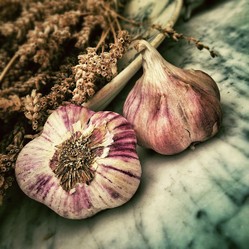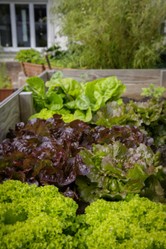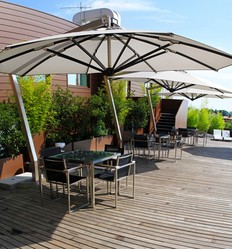It is vital to have a vision of what you want to achieve with your new garden. Your vision includes what sort of plants you want to grow. A friend of mine specializes in flowers. It includes whether you want to be a competition grower or not. Some ethnic minority growers grow favoured foods in their own ancestral lands. I have heard of a woman who grows herbs for medication and cosmetics. A vision should also include how you want the garden to progress, for example in two years time.
But your task begins with clearing any rubbish left by previous tenants of the garden. My son has to move an amount of scrap wood left by his predecessor. He is depositing it in a dumpster (skip) hired by the allotment management. But this is prior to clearing any weeds. Some weeds are baddies. Ragwort is a nuisance, as is creeping buttercup, which flourishes in the damp soils of north west England, and mare's tale, a Sicilian invasive, takes a long time to clear. These, along with others, need clearing. Weaker weeds can be tackled when hoeing the surface.
Get a good knowledge of your soil. This is vital. Find out whether the soil is clay, sando or silt, or as is most common, a loam, which is a mixture of all three. It is a good idea to find out the pH of your soil, whether it is acid, alkaline or, more rarely neutral. Acid soils are pH I to 6.5. Alkaline are 7.5 to fifteen. A pH of 6.5 to 7 does not need remediation. Knowing the pH helps if you want to grow acid loving plants. Some vegetables,such as cabbage, prefer a slight degree of alkalinity, a pH of 7,but they can tolerate some variation.
You also need to check the amount of organic matter in the soil. Ideally your soil should be dark,th le sign of a soil with a good level of organic matter. Organic matter is provided by compost,well rotted manure or seaweed. Leaf mold can be added, but it is not high in nutrients. Don't add fertilizer until you are ready to plant, when some can be added as a base dressing. Sometimes growers sweeten their soil with lime, but doing this is not always necessary, and as pH rating is on a logarithmic scale, moving from pH 6 to 7 is ten times harder than moving from 5 to 6.
It is useful to ask other plot holders whether there are any plant diseases endemic in the area. Club root is a common fungal disease of brassicas (cabbage family) and the only defence is a good dose of lime,but that is a preventative not a cure. Onion white rot is a bad guy. There is no cure, except to not grow onions on the infected bit for a long time. Silver leaf is a common disease of the plum family, I had to fell a much loved damson to get rid of it. These are just a few examples, so a good book on plant diseases would be useful.






 Pilgrimage. A review25 days ago
Pilgrimage. A review25 days ago
 Leo the Fourteenthon 05/09/2025
Leo the Fourteenthon 05/09/2025
 The Melsonby Hoardon 03/25/2025
The Melsonby Hoardon 03/25/2025




Comments
Flowers can have several different types per pot, depending,on pot size. Variety looks good. But wild flowers do not benefit from a rich soil. So do not let your soil be rich. On the Isle of Wight when the National Trust wanted patches of wild flowers on chalk headlands they stripped a layer of turf off the selected patches to keep the nutrient level down
Thank you for your comment below in answer to my previous observation and question.
The deeper planter, the marigold planting near carrots and the one-vegetable per pot advice is appreciated and doable.
Also, my wildflower packets offer me
alyssum;
baby's breath, bachelor button, black-eyed Susan, blue and scarlet flax;
calendula, catchfly, coreopsis, cosmos;
evening primrose;
Mexican hat;
wallflower;
yarrow.
Would you plant one wildflower per pot? How many would you plant in a windowsill planter?
There is no absolute rule on planting, but carrots should be in a deep planter to ensure that they elongate, but grow near to marigolds to deter carrot root fly. Vegetables grown in pots are usually one kind of veg per pot.
Thank you for your comment below in answer to my previous observation and question.
My vegetable-seed packets are
arugula;
beets;
canteloupe, carrots;
kohlrabi;
lettuce and romaine lettuce;
mustard;
onions;
parsnips;
radishes,
They additionally are squash as acorn, butternut and winter.
They also are Swiss chard.
Would you pot each vegetable type separately?
Would you put any together in windowsill planters?
Yes. Colour does not matter.
Thank you for your comment below in answer to my previous observation and question.
Last year my vegetable garden of around and on the front porch and in the basement can be called successful because of your advice about groupings, because of no casualties among the sparse amount planted of each vegetable and because of fresh and prepared tastiness.
This year I expect to focus upon basement- and ground floor-plantings in counter and table pots and in windowsill planters.
Tomorrow I hope to list for you my initial choices.
Arugula, beets, canteloupe and carrots for sure occur on that list.
But only orange carrots prevail on that list. (I will look for them during Friday grocery-store shopping tomorrow evening.)
Would red and purple carrots be consumed in the same fresh and prepared ways as orange carrots?
So you are getting thebsame we?ther as we are.since I had to give up the allotment due to my ill health I have had less space for vegetables. but your planting seems right.
Purple, but I like them all.
The computer crashed before I conveyed another component to my comment-box observation and question below.
University Extension on the Hawaiian archipelago designates 1 purple, 2 red and 6 orange carrot species as successfully plantable there.
Which color do you like of orange, purple, red options?
It has been cold March, April, May and even June.
The grass nevertheless has grown so it's waist-high around the vernal pool and in the north and the south meadows.
So it's a bit of a late start, what with hand-mowing and mowing, even as I launch into pots and windowsill planters.
Might you have time tomorrow -- if I organize my vegetables-to-plant this week -- to offer some sagely advice and experience?
My list, for starters, presents arugula, beets, canteloupe and carrots.